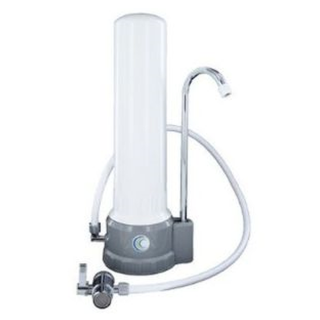Concerned About Fluoride In Your Drinking Water?
Fluoridation of public drinking water supplies started in the 1940s and has been justified by evidence that fluoride is effective at reducing cavities in both children and adults. However, many believe fluoride in drinking water does more harm than good and is an unnecessary form of “forced” medication.
Many countries, including nearly all of Europe, have discontinued fluoridation. And recently, in August of 2014, Israel outlawed fluoridation. The practice is allowed in many countries and the U.S., and about 70% of the U.S. residents currently receive fluoridated water. However, there's a long list of cities and communities have rejected fluoridation over the last decade or so.
Is Fluoride Bad For You?
It depends on who you ask and the degree of your exposure. The safety of fluoride in drinking water at levels recommended for preventing tooth decay has been asserted by numerous scientific and professional groups. But hundreds of renowned scientists and researchers around the world condemn, or refuse to endorse fluoridation of the water supply. Exposure to fluoride from other sources is increasing and adds to the exposure from fluoridated drinking water. These other sources include processed foods made with fluoridated water, fluoride-containing pesticides, bottled teas and many juice drinks, fluorinated pharmaceuticals and teflon pans.
Fluoride is unquestionably toxic at certain concentrations. Excessive fluoride exposure is well known to cause a painful bone disease known as skeletal fluorosis and a discoloration of the teeth known as dental fluorosis. Further, exposure to excessive fluoride also has been linked to a number of other disorders such as thyroid disease, gastrointestinal distress, arthritis, glucose intolerance, bone fragility, neurodegenerative diseases and possibly cardiovascular disease and some types of cancer.
NOTE: If your child is consuming infant formula, you should avoid making the formula with fluoridated tap water. Infant formula reconstituted with fluoridated water delivers a very high dose of fluoride to a young baby.
Because of the potential health effects, the U.S. Environmental Protection Agency has established national standards limiting the maximum allowable fluoride concentration in public water supplies. But even those standards have been questioned as perhaps been too lenient in a 2006 comprehensive study on fluoride by the National Research Council. Based on these and other concerns, the EPA recently announced, in April 2015, a proposed change in the recommended level for community water systems to 0.7 milligrams per liter (the low end of the prior recommended range of 0.7 to 1.2 milligrams per liter).
Fluoride is unquestionably toxic at certain concentrations. Excessive fluoride exposure is well known to cause a painful bone disease known as skeletal fluorosis and a discoloration of the teeth known as dental fluorosis. Further, exposure to excessive fluoride also has been linked to a number of other disorders such as thyroid disease, gastrointestinal distress, arthritis, glucose intolerance, bone fragility, neurodegenerative diseases and possibly cardiovascular disease and some types of cancer.
NOTE: If your child is consuming infant formula, you should avoid making the formula with fluoridated tap water. Infant formula reconstituted with fluoridated water delivers a very high dose of fluoride to a young baby.
Because of the potential health effects, the U.S. Environmental Protection Agency has established national standards limiting the maximum allowable fluoride concentration in public water supplies. But even those standards have been questioned as perhaps been too lenient in a 2006 comprehensive study on fluoride by the National Research Council. Based on these and other concerns, the EPA recently announced, in April 2015, a proposed change in the recommended level for community water systems to 0.7 milligrams per liter (the low end of the prior recommended range of 0.7 to 1.2 milligrams per liter).
What are your options if you wish to remove fluoride from your drinking water?
Distillation, ion exchange and reverse osmosis water treatment systems are very effective at removing fluoride from water. However, their use may be overkill if your objective is to remove nearly all fluoride from your drinking water. There are several different types of water filter systems that can remove more than 90% of the fluoride from your water, and they’re less expensive and much less complicated to operate and maintain than the other forms of treatment. A filter element designed specifically to reduce fluoride (and chlorine, heavy metals and numerous organic chemicals), the Aquametix filter element, is capable of reducing fluoride levels in your drinking water by as much as 90%.
The AquaCera HCP Counter-Top Fluoride Reduction Filter System is a free-standing, single-stage filter system. Its compact size and superior performance make it a good choice for your home, but it's also great for apartments, boats, RVs and second homes. And it's an excellent alternative to costly bottled water, reverse osmosis, distillation or ion exchange technologies.
Constructed of durable acetal and polyester materials, the filter housing holds a single replaceable filter element and it comes with of an AquaMetix filter element. This filter should be used only with water supplies that are municipally-treated where bacterial contamination is not an issue.
The HCP counter-top drinking water filter system allows filtered or unfiltered water to be drawn from your existing standard kitchen faucet. It connects easily to your standard kitchen faucet via an included diverter valve with no tools, and it requires no electricity or permanent modifications to your plumbing.
To obtain filtered water, you simply turn the knob on the diverter valve to direct water through the filter and filtered water is delivered through the attached spout. When you turn the diverter knob back, unfiltered water will flow again from the faucet into the sink.
NOTE: This system qualifies for free shipping within the continental U.S.
See other Fluoride reduction filter systems here.
Constructed of durable acetal and polyester materials, the filter housing holds a single replaceable filter element and it comes with of an AquaMetix filter element. This filter should be used only with water supplies that are municipally-treated where bacterial contamination is not an issue.
The HCP counter-top drinking water filter system allows filtered or unfiltered water to be drawn from your existing standard kitchen faucet. It connects easily to your standard kitchen faucet via an included diverter valve with no tools, and it requires no electricity or permanent modifications to your plumbing.
To obtain filtered water, you simply turn the knob on the diverter valve to direct water through the filter and filtered water is delivered through the attached spout. When you turn the diverter knob back, unfiltered water will flow again from the faucet into the sink.
NOTE: This system qualifies for free shipping within the continental U.S.
See other Fluoride reduction filter systems here.
NOTE:
• Other filter options for the HCP counter-top system are available here.
• Other counter-top water filter systems are available here.
• Several under-counter water filter systems are available here.
• Several gravity water filter systems are available here.
The AquaMetix water filter element is designed to provide the highest quality drinking water possible from a single stage block filter. This very unique adsorbent will adsorb and/or exchange a variety of organic and inorganic substances, including most heavy metals, chlorine and nitrogen compounds including ammonia, urea and chloramines.This filter will reduce a wide variety of drinking water contaminants of both aesthetic and health concerns. The dense pore structure and vast surface area is ideally suited to improving taste and odor, color, chemicals, MTBE, and fluoride.
Filter rating: 1.0 micron nominal
Turbidity reduction: 99.7%
Pathogenic organisms reduction: >99.999%
Cryptosporidium & Giardia removal: 100%
Contaminant reductions:
Chlorine >99%
Chloramine >99%
Fluoride >90%
Lead >99%
Arsenic >95%
Nitrates >92%
Metals -- Aluminum, Iron, Mercury, Nickel & Zinc reduction: >98%
VOCs > 98%
Herbicides >99%
Pharmaceutical compounds >95%
MTBE >97%
Capacity:
1,750 gallons -- Chloramine
1,150 gallons -- Lead




